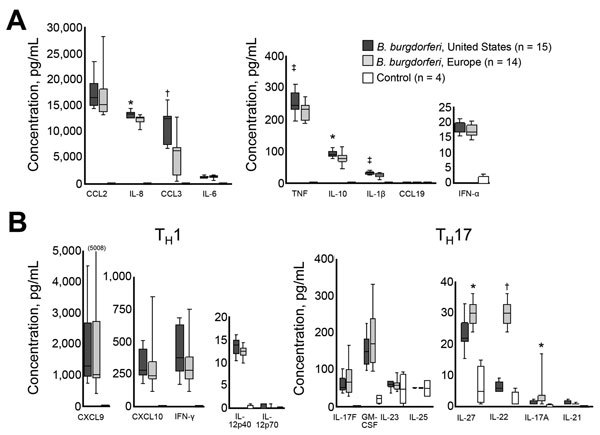Figure 5.

Inflammatory potential of Borrelia burgdorferi sensu stricto from Europe and the United States. Levels of 22 cytokines and chemokines associated with innate (A) or adaptive (B) immune responses. Innate responses: tumor necrosis factor (TNF), interleukin-1β (IL-1β), IL-6, IL-10, granulocyte–macrophage colony-stimulating factor (GM-CSF), IL-8, chemokine ligand 2 (CCL2), CCL3, and CCL19. Adaptive immune responses: Th1: interferon-γ (IFN-γ), IFN-α, IL-12p40, IL-12p70, cysteine-X-cysteine motif chemokine ligand 9 (CXCL9), and CXCL10; Th17: IL-17A, IL-17F, IL-21, IL-22, IL-23, IL-25, and IL-27. Immune responses were assessed in peripheral blood mononuclear cell culture supernatants after 7 days of stimulation with 14 B. burgdorferi sensu stricto isolates from Europe or 15 B. burgdorferi sensu stricto isolates from the United States (multiplicity of infection = 25) by using bead-based Luminex (EMD-Millipore, Darmstadt, Germany) multiplex assays. Each of 29 B. burgdorferi sensu stricto isolates was tested with peripheral blood mononuclear cells from each of 4 healthy donors in 4 independent experiments. Cytokine and chemokine values from the 4 experiments were averaged for analysis. Data are presented as box and whisker plots, boxes indicate interquartile ranges (1st and 3rd quartiles), lines inside boxes indicate median values, and error bars indicate 10th and 90th percentiles (value in parenthesis indicates the highest value). For comparison of B. burgdorferi sensu stricto isolates from Slovenia or the United States, *p<0.01, †p<0.001, ‡p<0.05.
